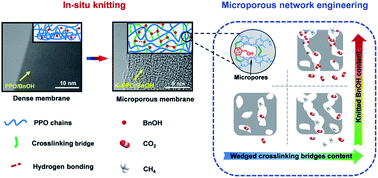In situ knitted microporous polymer membranes for efficient CO2 capture†
Abstract
Microporous polymer membranes hold great promise in carbon capture. However, engineering a continuous CO2-selective microporous network to achieve ultrahigh gas permeance and desirable selectivity remains a grand challenge. Aiming to manipulate the pore architecture and pore chemistry to implement efficient separation, knitted microporous polymer membranes are fabricated by in situ knitting composite membranes comprised of polyphenylene oxide (PPO) polymer and benzyl alcohol (BnOH). Specifically, the crosslinkers, formaldehyde dimethylacetal, bridge the neighboring aromatic backbones of PPO chains and BnOH to construct a highly crosslinked network with microporosity. By increasing the structural bridge density, the BET surface area of membranes increases from 4 to 538 m2 g−1. The formation of a highly interconnected microporous network provides remarkably increased permeability. Meanwhile, BnOH as a hydroxyl-containing functional building unit is knitted into micropore skeletons, which can directly tune the pore size and improve the CO2-philicity for enhanced selectivity. The resulting membrane displays an ultrahigh permeability of 4651.2 barrer with a CO2/CH4 selectivity of 27, and demonstrated good resistance to plasticization (up to 30 bar) and aging (for 190 days). This knitting strategy enabling versatile combination of building units with different structures and special functionalities may set up an innovative platform for fabricating a broad range of advanced membranes.



 Please wait while we load your content...
Please wait while we load your content...